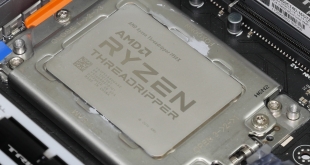
So what are the main features for AMD’s Threadripper CPUs? Firstly, the 12-core 1920X and 16-core 1950X will be available at launch, with the 8-core 1900X coming at the end of August. All CPUs feature AMD’s Simultaneous Multi-Threading (SMT) to double the logical processors available to an OS. An unlocked core ratio multiplier allows the chips to be overclocked. Each chip supports quad-channel memory, including ECC compatibility, and 64 PCIe lanes (60 of which can be used for expansion devices with 4 going to the X399 chipset). They slot into the new TR4 socket which features 4094 pins and is based on the AMD EPYC server processor design.
Focussing more on the 1920X and 1950X CPUs, AMD’s multi-die approach means that these chips are basically a pair of Ryzen 5 1600X (for the 12-core 1920X) or Ryzen 7 1800X (for the 16-core 1950X) CPU dies communicating with each other over Infinity Fabric. That means you get the two 4-core Core Complexes (CCXs) forming each of the dies for the 1950X and the two 3-core CCXs making each of the dies for the 1920X. Given the symmetrical core layout approach deployed by AMD, do not expect to see 10- or 14-core Threadripper chips unless a change of methods is deployed.
This method of creating a multi-die CPU, rather than the largely monolithic approach deployed by Intel, can potentially give AMD a cost advantage for high core count parts. Yields on ‘perfect’ high core count, larger CPUs are naturally lower than those on smaller dies. However, fabbing multiple smaller dies and allowing them to work together can give the high core count end result without the penalty of challenging yields.
That previous multi-die point also explains why Threadripper looks a lot like double a Ryzen 7 or Ryzen 5 chip and half an EPYC processor. That’s basically what it is. And in some respects, that can be a positive. For example, the clock speeds available to Threadripper parts are basically identical to those of the smaller Ryzen chips which is certainly not the case for Intel’s competing Skylake-X/Kaby Lake-X line-up.
AMD is clearly targeting consumers and prosumers with extremely heavy computational requirements. Gamers who want to stream and transcode simultaneously, 3D renderers who need all the CPU cores they can get, tweakers who want multiple high-performance VMs, videographers who need to edit and render high-res video without crippling their system. They are some of the target users for AMD’s Ryzen Threadripper CPUs and the X399 platform as whole.
On the topic of the X399 platform, AMD is taking a different approach to Intel by heavily leveraging on-CPU connectivity resources as opposed to on-chipset options. As such, the X399 chipset only features two general purpose PCIe Gen 3 lanes and eight PCIe 2.0 lanes (compared to up to 24 PCIe 3.0 lanes for X299). Two 10Gbps USB 3.1 Gen 2 and six 5Gbps Gen 1 connections are made available alongside eight SATA 6Gbps links with RAID 0, 1, and 10 support. The Threadripper SoC adds a further eight 5Gbps USB 3.1 Gen 1 connections to the pool as well as four SATA links, should the motherboard vendor choose to deploy them.
However, the CPU is where the real connectivity limelight shines. The 64 PCIe Gen 3 lanes (four of which are reserved for chipset connection) can be used by up to seven PCIe devices natively, or more with the addition of a clock gen. For example, three x16 GPUs and three x4 PCIe NVMe SSDs can be used simultaneously. With 10GbE networking connectivity and high-bandwidth RAID cards in the picture, those PCIe lanes can be eaten quickly.
Unlike Intel’s competition, a user does not have to worry about DMI bottlenecks when using multiple PCIe SSDs. However, Intel now offers VROC to allow for PCIe NVMe SSD RAID linked directly to the CPU. NVMe RAID is not currently supported by the X399 platform, which is undeniably disappointing.
| CPU | AMD Ryzen Threadripper 1950X | AMD Ryzen Threadripper 1920X | Intel Core i9 7900X | AMD Ryzen 7 1800X | Intel Core i7 6950X | Intel Core i7 7700K |
| CPU Codename | Threadripper | Threadripper | Skylake-X | Zen | Broadwell-E | Kaby Lake |
| Core / Threads |
16 / 32 | 12 / 24 | 10 / 20 | 8 / 16 | 10 / 20 | 4 / 8 |
| Base Frequency | 3.4GHz | 3.5GHz | 3.3GHz | 3.6GHz | 3.0GHz | 4.2GHz |
| All-Core Frequency | 3.7GHz | 3.7GHz | 4.0GHz | 3.7GHz | 3.4GHz | 4.4GHz |
| Boost Frequency | 4.0GHz | 4.0GHz | 4.3GHz | 4.0GHz | 3.5GHz | 4.5GHz |
| Maximum Frequency (XFR / TBM 3.0) |
Up to 4.2GHz (XFR, 4 cores) | Up to 4.2GHz (XFR, 4 cores) | Up to 4.5GHz (TBM 3.0, 2 cores) | Up to 4.1GHz (XFR, 2 cores) | Up to 4.0GHz (TBM 3.0, 1 core) | n/a |
| Unlocked Core Multiplier | Yes (x0.25 granularity) | Yes (x0.25 granularity) | Yes (x1 granularity) | Yes (x0.25 granularity) | Yes (x1 granularity) | Yes (x1 granularity) |
| L3 Cache | 32MB | 32MB | 13.75MB | 16MB | 25MB | 8MB |
| Max. Memory Channels |
4 (DDR4) | 4 (DDR4) | 4 (DDR4) | 2 (DDR4) | 4 (DDR4) | 2 (DDR4 & DDR3L) |
| Max. Memory Frequency (Native) |
1866 to 2667MHz | 1866 to 2667MHz | 2666MHz | 1866 to 2667MHz | 2400MHz | 2400MHz / 1600MHz |
| PCIe Lanes | 60+4 | 60+4 | 44 | 16+4+4 | 40 | 16 |
| CPU Socket | TR4 | TR4 | LGA 2066 | AM4 | LGA 2011-3 | LGA 1151 |
| Manufacturing Process | 14nm | 14nm | 14nm | 14nm | 14nm | 14nm |
| TDP | 180W | 180W | 140W | 95W | 140W | 91W |
| MSRP | $999 | $799 | $999 | $499 | $1723-1743 | $339-350 |
| UK Street Price (Aug 2017) |
£999 | £799 | Approx. £860 | Approx. £420 | Approx. £1325 | Approx. £325 |
Looking at the table, $999 to AMD nets you the 16C32T Threadripper 1950X with 60 usable PCIe 3.0 lanes and more L3 cache than Intel’s i9-7900X. However, the $999 Core i9 features higher clock speeds and a lower TDP.
Speaking of TDP, both Ryzen Threadripper parts are rated at a hefty 180W. However, do not confuse TDP with power consumption as the two metrics are only loosely related. What a 180W TDP does say, however, is that you need a hefty cooler to keep the CPUs happy even at stock clocks.
Memory speed support is the same 1866 to 2667MHz as observed with Ryzen 7. AMD validates Threadripper for single-rank DIMMs at 2667MHz for four sticks (1DPC) and 2133MHz for eight sticks (2DPC), while dual-rank DIMMs are 2400MHz for four sticks and 1866MHz for eight sticks. Interestingly, AMD also claims support for up to 512GB of memory per channel, giving 2TB(!) in total. Such numbers will not work on most Windows 10 versions (currently) and will require the use of future higher-capacity UDIMMs.
Ryzen’s L2 cache per core is 512K, giving the 12-core 1920X 6MB total and the 16-core 1950X 8MB total. That’s lower than the 1MB L2 cache per core for Intel’s re-balanced Skylake-X chips. AMD makes up for that with 32MB L3 cache split across the two dies, as opposed to 13.75MB L3 cache for the i9-7900X. AMD’s die-based L3 cache approach gives the 12-core 1920X more L3 cache per core than its 16-core 1920X counterpart.
One point worth noting is the XFR clock speed for both Ryzen Threadripper CPUs. AMD’s previous maximum XFR frequency was 4.1GHz with the Ryzen 7 1800X and Ryzen 5 1600X. AMD has binned the best Ryzen dies and pushed that maximum clock speed up to 4.2GHz but now on 4 cores. In theory, four of Ryzen Threadripper 1920X’s and 1950X’s cores can operate up to 4.2GHz if other thermal and power headroom limitations are met. You still get the same SenseMI technologies as are on all Ryzen CPUs, with Precision Boost still allowing for rapid progression through clock speed states in 25MHz steps.
For more information on the Zen architecture, see our Ryzen 7 1800X launch review HERE. For more information relating specifically to Ryzen Threadripper and its features such as Distributed and Local memory modes, as well as Legacy Compatibility Mode, see our Threadripper announcement coverage HERE. You can watch our unboxing video HERE.
Our objective with CPU overclocking is to hit frequencies that we think will be achievable for daily use by the platform’s buyers. As such, we test with sensible cooling hardware in the Thermaltake Floe Riing 360, which is a 3x120mm Asetek-based AIO liquid cooler. Our usual Corsair H110i GT is not compatible with the new TR4 socket. We also used sensible voltages that lead to manageable thermal results.
Stability is confirmed by running multiple Cinebench tests, Handbrake video conversion, and AIDA64 CPU, FPU, and Cache stress test for at least 1 hour. We do not use Prime95 as we have found it to be overly demanding as a stress test application with the more recent AVX-capable versions.
The partnering hardware of choice is the ASUS ROG Zenith Extreme X399 motherboard, 32GB of G.SKILL TridentZ 3200MHz CL14 DDR4, and a Seasonic 760W Platinum PSU. We chose the ASUS motherboard due to its strong power delivery system, dual 8-pin power connectors, and active VRM cooling. We also point a 100mm Antec Spot Cool at the VRM heatsink to provide additional direct airflow for cooling.
16-core 1950X:
Overclocking with the Ryzen Threadripper 1950X is very similar to the procedure with other Ryzen chips. We were able to hit 3.9GHz very easily with minimal adjustment to the system – we simply applied 1.4V VCore in the UEFI and opted for the Level 1 LLC setting. We pushed a little further and managed to hit 4.0GHz with Cinebench and Handbrake stability but AIDA64 would not pass its stability test.
We finally settled on 3.95GHz across all 16 cores with a UEFI-set voltage of 1.3875V and Level 1 LLC (which resulted in 1.395V under load). These settings kept temperatures (just about) in check at below 85°C using the 360mm AIO cooler. Power draw from the wall would peak at more than 500W(!) during Cinebench's CPU-only load!
In short, our final Ryzen Threadripper 1950X overclocking settings were:
- 3.95GHz on all cores.
- 1.3875V CPU VCore (in the UEFI).
- Level 1 LLC (around 1.395V Cinebench and AIDA 64 load VCore in OS, according to software and multimeter readings).
- Multiple Cinebench R15 multi-core runs to validate stability, as well as AIDA64 CPU stress test.
- DDR4-3200MHz 14-14-14-34 @ 1.35V.
12-core 1920X:
1920X overclocking was basically identical to the 1950X. We managed to maintain full stability at 4.0GHz with the 12-core chip, however. This was using the same 1.3875V core voltage in the UEFI (1.395V loaded in the OS). Despite the reduction in core count, temperatures were still as high as they were on the 1950X while running the AIDA64 stress test.
The 360mm AIO kept the chip just below the throttling point and power draw was reduced by roughly 100W compared to the 16-core.
In short, our final Ryzen Threadripper 1920X overclocking settings were:
- 4.0GHz on all cores.
- 1.3875V CPU VCore (in the UEFI).
- Level 1 LLC (around 1.395V Cinebench and AIDA 64 load VCore in OS, according to software and multimeter readings).
- Multiple Cinebench R15 multi-core runs to validate stability, as well as AIDA64 CPU stress test.
- DDR4-3200MHz 14-14-14-34 @ 1.35V.
Overclocking comments:
Our overclocking results with the Ryzen Threadripper processors were generally positive. We managed roughly the same frequencies that we tend to see on Ryzen CPUs with lower core counts. All-core overclocks of 4.0GHz, or very close to it, were possible when feeding 1.4V to the chips. You may be able to hit a faster clock speed with a higher voltage but this will necessitate cooling better than a 360mm AIO (custom liquid cooling).
The 4.6GHz clock that is generally possible on Intel Core i9-7900X CPUs may prove tough competition for the 4GHz Threadripper 12 core. However, 4.0GHz across 16 or 12 cores is a solid result that should net decent performance gains.
We will be outlining the Ryzen Threadripper CPUs' performance while using an ASUS ROG Zenith Extreme X399 Socket TR4 motherboard. A 32GB (4x8GB) kit of G.Skill's 3200MHz CL14 DDR4 memory serves our test system.
Today's comparison processors come in the form of:
- Skylake-X i9-7900X (10C20T).
- Broadwell-E i7-6800K (6C12T) and i7-6950X (10C20T).
- Kaby Lake (and Kaby Lake-X) i7-7700K (4C8T) and i7-7740X (4C8T).
- Ryzen 7's 1700 (8C16T) and 1800X (8C16T).
- Ryzen 5's 1600X (6C12T).
Each processor is tested at its default out-of-the-box settings and when overclocked to a reasonable level. For the Intel CPUs, we ensured that forced-turbo was disabled so that Intel's defined Turbo Boost parameters were functioning correctly. As such, all-core load frequencies for the tested chips are as follows:
- Ryzen Threadripper 1950X = 3.7GHz.
- Ryzen Threadripper 1920X = 3.7GHz.
- Core i9-7900X = 4.0GHz (most of the time, with Handbrake or synthetic stress tests as an exception).
- Core i7-6950X = 3.4GHz (most of the time, with Handbrake or synthetic stress tests as an exception).
- Ryzen 7 1800X = 3.7GHz.
- Ryzen 7 1700 = 3.2GHz.
- Core i7-6800K = 3.5GHz.
- Core i7-7740X = 4.5GHz.
- Core i7-7700K = 4.4GHz.
- Ryzen 5 1600X = 3.7GHz.
CPU Test System Common Components:
- Graphics Card: Nvidia GeForce GTX 1080 Ti Founders Edition (custom fan curve to eliminate thermal throttling).
- CPU Cooler: Corsair H110i GT & Thermaltake Floe Riing 360 for AMD Threadripper Socket TR4 CPUs.
- Games SSD: SK hynix SE3010 SATA 6Gbps 960GB.
- Power Supply: Seasonic Platinum 760W.
- Operating System: Windows 10 Pro 64-bit (Creators Edition).
Ryzen Threadripper X399 System (Ryzen TR 1950X, Ryzen TR 1920X):
- Ryzen TR 1950X CPU: AMD Ryzen Threadripper 1950X ‘Threadripper' 16 cores, 32 threads (3.95GHz @ 1.3875V overclocked).
- Ryzen TR 1920X CPU: AMD Ryzen Threadripper 1920X ‘Threadripper' 12 cores, 24 threads (4.0GHz @ 1.3875V overclocked).
- Motherboard: ASUS ROG Zenith Extreme (TR4, X399).
- Memory: 32GB (4x8GB) G.Skill Trident Z 3200MHz 14-14-14-34 DDR4 @ 1.35V.
- System Drive: Crucial MX300 525GB.
Skylake-X LGA 2066 System (i7-7740X, i9-7900X):
- 7740X CPU: Intel Core i7 7740X ‘Kaby Lake-X' (ES) 4 cores, 8 threads (5.1GHz @ 1.30V overclocked).
- 7900X CPU: Intel Core i9 7900X ‘Skylake-X' (ES) 10 cores, 20 threads (4.6GHz @ 1.20V overclocked).
- Motherboard: ASUS X299-Deluxe (LGA 2066, X299).
- Memory: 16GB (2x8GB) or 32GB (4x8GB) G.Skill Trident Z 3200MHz 14-14-14-34 DDR4 @ 1.35V.
- System Drive: Samsung 840 500GB.
Ryzen AM4 System (Ryzen 5 1600X, Ryzen 7 1700, Ryzen 7 1800X):
- 1800X CPU: AMD Ryzen 7 1800X ‘Summit Ridge' 8 cores, 16 threads (4.05GHz @ 1.425V overclocked).
- 1700 CPU: AMD Ryzen 7 1700 ‘Summit Ridge' 8 cores, 16 threads.
- 1600X CPU: AMD Ryzen 5 1600X ‘Summit Ridge' 6 cores, 12 threads (4.0GHz @ 1.4125V overclocked).
- Motherboard: Gigabyte Aorus AX370-Gaming 5 & ASUS Crosshair VI Hero (AM4, X370, AGESA 1006).
- Memory: 16GB (2x8GB) G.Skill FlareX 3200MHz 14-14-14-34 DDR4 @ 1.35V.
- System Drive: SanDisk Ultra Plus 256GB.
Kaby Lake LGA 1151 System (i7-7700K):
- 7700K CPU: Intel Core i7-7700K ‘Kaby Lake' (Retail) 4 cores, 8 threads (4.8GHz @ 1.35V overclocked).
- Motherboard: ASUS Maximus VIII Hero (LGA 1151, Z170).
- Memory: 16GB (2x8GB) G.Skill FlareX 3200MHz 14-14-14-34 DDR4 @ 1.35V.
- System Drive: Micron M600 256GB.
Broadwell-E LGA 2011-3 System (i7-6800K, i7-6950X):
- 6800K CPU: Intel Core i7 6800K ‘Broadwell-E' (Retail) 6 cores, 12 threads (4.2GHz @ 1.275V overclocked).
- 6950X CPU: Intel Core i7 6950X ‘Broadwell-E' (Retail) 10 cores, 20 threads (4.2GHz @ 1.275V overclocked).
- Motherboard: ASUS ROG Strix X99 Gaming (LGA 2011-v3, X99).
- Memory: 32GB (4x8GB) G.Skill Trident Z 3200MHz 14-14-14-34 DDR4 @ 1.35V (at 3000MHz for the 6800K due to IMC weakness).
- System Drive: Kingston HyperX 3K 120GB.
Software:
- ASUS ROG Zenith Extreme BIOS v9960 (pre-release).
- GeForce 382.33 VGA drivers.
Tests:
Productivity-related:
- Cinebench R15 – All-core & single-core CPU benchmark (CPU)
- HandBrake – Convert 6.27GB 4K video recording using the Normal Profile setting and MP4 container (CPU)
- Mozilla Kraken – Browser-based JavaScript benchmark (CPU)
- x265 Benchmark – 1080p H.265/HEVC encoding benchmark (CPU)
- 7-Zip – Built-in 7-Zip benchmark test (CPU & Memory)
- SiSoft Sandra – Memory bandwidth (Memory)
Gaming-related:
- 3DMark Time Spy – Time Spy (DX12) test (Gaming)
- Ashes of the Singularity Escalation – Built-in benchmark tool CPU-Focused test, 1920 x 1080, Extreme quality preset, DX12 version (Gaming)
- Ghost Recon: Wildlands – Built-in benchmark tool, 1920 x 1080, Very High quality preset, DX12 (Gaming)
- Grand Theft Auto V – Built-in benchmark tool, 1920 x 1080, Maximum quality settings, Maximum Advanced Graphics, DX11 (Gaming)
- Metro: Last Light Redux – Built-in benchmark tool, 1920 x 1080, Very High quality settings, SSAA Enabled, AF 16X, High Tessellation, DX11 (Gaming)
- Total War Warhammer – Built-in benchmark tool, 1920 x 1080, Ultra quality preset, DX12 version (Gaming)
Cinebench
Cinebench is an application which renders a photorealistic 3D scene to benchmark a computer’s rendering performance, on one CPU core, all CPU cores or using the GPU. We run the test using the all-core CPU and single-thread CPU modes.
Handbrake Conversion
Handbrake is a free and open-source video transcoding tool that can be used to convert video files between different codecs, formats and resolutions. We measured the average frame rate achieved for a task of converting a 6.27GB 4K video using the Normal Profile setting and MP4 container. The test stresses all CPU cores to 100% and shows an affinity for memory bandwidth.
x265 Encoding
x265 Encoding tests system performance by encoding a 1080p test file using the x265/HEVC format.
Overview:
Both Threadripper chips make blazing starts in the Cinebench multi-threaded tests. Hitting around 3000 Cinebench points out of the box, the 1950X opens up a new level of rendering performance, based on the Cinebench numbers. Stock vs stock, AMD's equally-priced 1950X is 37% faster than the i9-7900X. With both overclocked, the AMD chip's lead is 39%. Even the $200 cheaper 1920X hands the $999 i9-7900X a beating by being 13% faster at stock and 7.6% faster with both overclocked.
Keeping the focus on Cinebench multithreaded, the performance scaling from AMD's increase core count is near perfect. The 12C24T 3.7GHz all-core 1920X is 99.5% faster than the 6C12T 3.7GHz all-core Ryzen 5 1600X. A 99.5% performance uptick for a 100% increase in cores is pretty good indeed! Performance scaling from the Ryzen 7 1800X to the Ryzen Threadripper 1950X was not as close to 100% due to the 16-core chip reducing its all-core Precision Boost clock speed to around 3.475GHz under heavy load (likely due to TDP limitations).
Looking at Cinebench single-threaded performance, Intel's higher-clocked parts with superior Skylake- or Kaby Lake-based microarchitecture are still the champs. Nothing from AMD can touch the single-threaded performance of Skylake-based chips. 4.2GHz XFR seems to be a little hit-or-miss with our Cinebench tests, as shown by the 1920X outperforming the 1950X (which shouldn't be the case due to 4.2GHz XFR on both). Run-to-run variance with Cinebench also plays a role.
Moving on to Handbrake, the 1950X forces its way to another performance victory. In fact, the 12-core and 16-core chips have so much processing power and so many threads, our high-bitrate 4K conversion tasks was struggling to saturate all resources. Despite operating at around 80% overall usage, the 1950X still managed to outperform Intel's i9-7900X by 20% stock vs stock and 14% OC vs OC. That's with enough CPU horsepower spare on the 1950X to theoretically just about run Ghost Recon Wildlands at 4K at the same time, for example.
The 1920X sat closer to 100% CPU usage in Handbrake most of the time and in doing so, proved competitive against the more expensive i9-7900X.
Our x265 benchmark was another test that simply could not feed the sheer number of threads made available by the Ryzen Threadripper CPUs (and Intel 10-core chips by extension but to less of a degree). As such, the test showed increased preference for clock speed over thread count past a certain number. Intel's Skylake-X i9-7900X was outperformed by the 1950X by 16% and by the 1920X by 4.3% for stock vs stock. However, a 4.6GHz clock speed netted the Intel flagship a performance lead of 5.4% against the 1950X and 17% compared to the 1920X with all CPUs overclocked.
Its 4.6GHz clock speed allow Intel's Core i9-7900X to load all threads to around 90-100% when encoding. However, the 1950X's 3.95GHz frequency meant that average CPU usage was around 60-75%. In this test, that makes Intel's chip good for users who want all-out performance and AMD's similarly-priced competitor a smart option for heavy multi-taskers.
7-Zip
7-Zip is an open source Windows utility for manipulating archives. We measure the Total Rating performance using the built-in benchmark tool. The test stresses all CPU cores to 100% and shows an affinity for memory bandwidth.
Mozilla Kraken
Mozilla Kraken is a browser-based JavaScript benchmark that tests a variety of real-world use cases. We use Chrome as the test browser. The test exhibits very little multi-threading and shows an affinity for CPU clock speed and IPC.
Sandra Memory Bandwidth
Overview:
7-Zip performance is very strong on Threadripper as all cores and threads can be saturated in the tool's benchmark test. AMD's Ryzen CPUs prove particularly strong for decompression while Intel shows similar numbers for compression and decompression. Overall, the 1950X beats the i9-7900X by 24% stock vs stock and 17% OC vs OC. However, decompressing performance is around 95000 MIPS for the 1950X OC and around 65000 MIPS for the i9-7900X OC. By comparison, compressing performance is around 61000 MIPS for the 1950X OC and around 67000 for the i9-7900X OC.
Mozilla Kraken benchmark likes clock speed so it comes as no surprise to see Intel chips grouping towards the top of the chart. The i9-7900X comfortably outperforms both Threadripper chips thanks to its architectural IPC and clock speed advantages at stock frequencies (with TBM 3.0) and when overclocked.
Memory Bandwidth for the quad-channel Ryzen Threadripper systems is over 60GBps and beats out all Intel competitors when using 3200MHz CL14 memory. In our testing, the 12-core 1920X netted 66.5GBps of memory bandwidth which was higher than the 16-core 1950X's 62.1GBps. This is similar to the 6-core Ryzen 5 1600X outperforming the 8-core Ryzen 7 1800X, perhaps due to greater capacity for the Infinity Fabric to reach out to memory rather than inter-CCX communication for more cores.
One of Ryzen 7's biggest weakness was its ability to offer high core counts but without the memory bandwidth to match. Threadripper solves that issue convincingly. It must, however, be pointed out that Intel's competing X299 platform and Skylake-X chips are generally able to support quad-channel memory frequencies in excess of 4GHz. Such memory kits may change the memory bandwidth picture.
Despite greater memory bandwidth for AMD, Intel still has the memory latency advantage in our testing. AIDA64 gave the Ryzen Threadripper CPUs close to 90ns memory latency whereas the i9-7900X scored close to 70ns. Memory latency is an area that AMD's Local Memory Access mode in Ryzen Master aims to address.
3DMark
3DMark is a multi-platform hardware benchmark designed to test varying resolutions and detail levels of 3D gaming performance. We run the Windows platform test and in particular the Fire Strike benchmark, which is indicative of high-end 1080p PC Gaming. We also test using the Time Spy benchmark which gives an indication of DirectX 12 performance.
Grand Theft Auto V
Grand Theft Auto V remains an immensely popular game for PC gamers and as such retains its place in our test suite. The well-designed game engine is capable of providing heavy stress to a number of system components, including the GPU, CPU, and Memory, and can highlight performance differences between motherboards.
We run the built-in benchmark using a 1080p resolution and generally Maximum quality settings (including Advanced Graphics).
Metro: Last Light Redux
Despite its age, Metro: Last Light Redux remains a punishing title for modern computer hardware. We use the game's built-in benchmark with quality set to Very High, SSAA enabled, AF 16X, and High tessellation.
Gaming Performance Overview:
It is unsurprising by now that AMD loses to Intel when it comes to all-out gaming performance. The clock speed advantages on Intel's chips, as well as years of game development tuned for Intel hardware, generally put AMD processors at a performance deficit when looking at the high-end options.
3DMark Time Spy is well multi-threaded and therefore displays positive results with Threadripper. However, Intel's higher-clocked 10-core chips steal top spot away from the AMD offerings. Time Spy gives an indication that, even with the DX12 API, core count is less important than clock speed past a certain point.
Grand Theft Auto V is known to show preference for Intel hardware but the game's immense popularity and ability to stress CPUs justifies its reoccurrence in our test suite. The Ryzen chips, Threadripper included, generally hit a wall at around 90 FPS average using the maximum quality settings at 1080P. By comparison, Intel's chips including the i9-7900X can break through the 100 FPS average barrier.
If you are interested in high refresh rate gaming on your HEDT CPU, Intel's i9-7900X will be the better option for GTA V. With that said, minimum FPS numbers from Ryzen Threadripper are positive (despite the variance posed by the GTA V benchmark).
Metro: Last Light Redux is proof that any of these CPUs is perfectly capable of running certain GPU-limited games at high refresh rates. Threadripper chips still gravitate towards the lowest performance points on the chart and Skylake-X is marginally faster. However, the differences in this title are minimal between all CPUs and are limited by GPU performance (which is a more likely scenario for modern games and higher resolutions).
Ashes of the Singularity Escalation
Ashes of the Singularity Escalation is a Sci-Fi real-time strategy game built for the PC platform. The game includes a built-in benchmark tool with DirectX 12 support. We run the CPU-focused benchmark using DirectX 12, a 1080p resolution and the Extreme quality preset.
Ghost Recon Wildlands
Tom Clancy’s Ghost Recon Wildlands is an open world tactical shooter video game developed by Ubisoft Paris. It is the tenth instalment in the Tom Clancy’s Ghost Recon franchise and is the first Ghost Recon game to feature an open world environment.
We run the built-in benchmark using a 1080P resolution and the Very High quality preset.
Total War: Warhammer
Total War: Warhammer is another title which features both DX11 and DX12 modes. Heavy loading can be placed on the CPU using the built-in benchmark. The DX12 mode is poorly optimised and tries to force data through a low number of CPU threads rather than balance operations across multiple cores. As such, this gives a good look at pure gaming performance of each CPU in titles that aren't well multi-threaded.
We run the built-in benchmark using the DirectX 12 mode, a 1080p resolution, and the Ultra quality preset.
Gaming Performance Overview:
Ashes of the Singularity: Escalation is able to leverage a significant number of threads using its DX12 mode. This helps Threadripper performance but only to a limited extent. Intel's competitor in the i9-7900X is faster than the fastest Threadripper chip irrelevant of whether or not it is overclocked.
Ghost Recon Wildlands performs very well on all CPUs when coupled with a GTX 1080 Ti and the Very High preset. The Threadripper chips average around 110 FPS with minimums close to 100 FPS, making them perfectly capable of offering high refresh rate performance. Intel's Core i7 and i9 chips are generally a little faster than Ryzen offerings but the performance margins are small.
In its DX12 mode, Total War: Warhammer is driven almost entirely by the maximum performance offered by a single thread. As such, the maximum frequency on offer from a fast processor architecture will win the performance battle. That's a negative for AMD's chips, including Threadripper, as their Intel competitors tend to offer higher clock speeds on the slightly better Skylake microarchitecture.
Even with performance deficits thrown the 7900X's way due to cache rebalancing, Intel's $999 flagship still manages to outperform Threadripper offerings. While this is certainly a victory for Intel, positives for AMD can be taken from the fact that Total War: Warhammer is clearly still so poorly optimised for multi-threaded CPUs that performance regresses from Ryzen 5/7 to Threadripper.
The market for people buying an expensive CPU and using it for gaming at 1080p is likely to be very slim. What 1080p does is give a good indication of the CPU's raw gaming performance as GPU power is sufficient to push frame rates to a level where the CPU and memory limitations can be observed.
We supplement the 1080p gaming results with a pair of games tested at 4K. We chose Ghost Recon Wildlands and GTA V as they are computationally-heavy, open-world games with good built-in benchmarks.
Ghost Recon Wildlands
We run the built-in benchmark using a 4K resolution and the same settings as the 1080p test (Very High preset).
Grand Theft Auto V
We run the built-in benchmark using a 4K resolution and the same settings as the 1080p test (generally Maximum quality settings including Advanced Graphics).
4K Gaming Performance Overview:
Intel's Kaby Lake quad-cores, such as the i7-7700K, tend to be fractionally faster in Ghost Recon Wildlands but the realistic difference is negligible and more commonly due to numerical rounding.
GTA V still shows preference for Intel hardware even at 4K but the performance difference is minor at around 5 FPS on average (around 7%). Minimum FPS performance remains strong for Threadripper, despite the variance induced by GTA V's benchmark. However, overclocking the 12- and 16-core chips repeatedly reduced the minimum FPS figures slightly. This may be due to the reduced all-core frequency compared to the stock-clocked XFR boost capabilities.
For 4K60 gamers, all of the CPUs on show are perfectly good options.
We leave the system to idle on the Windows 10 desktop for 5 minutes before taking a power draw reading. For CPU load results, we read the power draw while producing five runs of the Cinebench multi-threaded test. We also run 5 minutes of AIDA64 stress test to validate data and because Cinebench runs on high core count CPUs are completed very quickly.
The power consumption of our entire test system (at the wall) is shown in the chart. The same test parameters were used for temperature readings.
Power Consumption
Power draw readings are accurate to around +/-5-10W under heavy load due to instantaneous fluctuations in the value. We use a Platinum-rated Seasonic 760W PSU (with 8-pin plus 4-pin or 8-pin power connectors where possible) and install a GTX 1070 video card that uses very little power.
Power usage from the Ryzen Threadripper CPUs is very high even at stock. Even with the 16-core chip reducing its Precision Boost clock speed to around 3.475GHz under heavy Cinebench and AIDA64 loading, the 1950X system still commands over 330W from the wall. The 1920X isn't far behind at around 320W load usage thanks to its ability to maintain Precision Boost clocks of 3.7GHz on all cores.
Factor in an overclock to around 4GHz with 1.4V on either Threadripper CPU and power draw jumps even higher. The 12-core 1920X crept deep into the 400W range under the sustained battering from AIDA64, while the 16-core 1950X pushed past 520W when being stressed (and even higher in some of our earlier testing with 1.42V).
This really is a very simple equation; if you want the performance offered by Ryzen Threadripper, you have no choice but to invest in a high-quality, high-capacity power supply. 850W is a good starting point for an overclocked 1920X and a single graphics card such as the GTX 1080 Ti. 1000W would be my recommendation to users looking to overclock the 1950X alongside their one GTX 1080 Ti-like GPU. An overclocked 1950X combined with a couple of Vega cards may start to make 1300W+ PSUs look like a smart buy for long-term use.
The high power draw of both Threadripper CPUs looks far more justifiable when interpreted on a performance-per-Watt basis. The stock-clocked 1950X puts in a very strong efficiency result in Cinebench, only being beaten by the superb Ryzen 7 1700. The 12-core 1920X sits slightly Intel Core i7-6950X and slightly above the Core i9-7900X on the efficiency chart.
Shifting the focus to overclocked numbers, Ryzen Threadripper continues to show strong performance-per-Watt numbers. The 16-core 1950X offers the joint best result, matching the 8-core Ryzen 7 1800X that practically forms one of the Threadripper dies. Not far behind on the efficiency spectrum is the 12-core 1920X. Both Threadripper chips outdo the efficiency of Intel's competing overclocked parts in our testing.
Of course, this chart is comprised only of Cinebench results – a benchmark that is known to scale very well with thread count. However, it does give an insight that Ryzen Threadripper can be performance-efficient processor despite its high TDP rating and actual power draw. If time is money for your heavily multi-threaded workloads and efficiency is an important factor, Ryzen Threadripper looks like a competitive solution.
Temperatures
Temperature recordings were taken using a 360mm Thermaltake Floe Riing 360 Asetek-based all-in-one liquid cooler with its three fans running in ‘Performance' mode (up to 1600 RPM). Unfortunately, the Corsair H110i GT AIO used for comparison CPUs is currently incompatible with the TR4 socket. As such, direct comparisons to other processors' thermal performance cannot be made. Ambient temperatures were held around 23°C (and normalised to 23°C where there were slight fluctuations).
We read the Tdie reading for Ryzen Threadripper which accounts for the 27°C offset. The same Tdie temperature for Ryzen accounts for the 20°C temperature offset. The charted temperatures are without the 20°C/27°C offset added on (making them ‘real' Tdie readings). Some Ryzen idle temperatures are omitted due to inaccurate readings caused by sensor drift. Ryzen 7 1700 temperature data is omitted as the numbers are incorrect (sometimes sub-ambient).
Note: The asterisk denotes the use of a different CPU cooler for Ryzen Threadripper CPUs compared to other CPUs.
Thermal performance from the Ryzen Threadripper CPUs is good given the power draw and performance offered. However, there's no denying that the actual CPU temperatures are high. Using a 360mm AIO cooler with 1600 RPM fans, both chips hovered around 60°C when loaded at stock clocks. The 1950X would reduce its all-core frequency from 3.7GHz to around 3.475GHz under heavy Cinebench and AIDA64 loading, though this did not look to be temperature-induced.
Overclocking the chips to around 4GHz using 1.4V will push temperatures into the 70°C and 80°C range. Surprisingly, our overclocked 1950X ran a little cooler under AIDA64 load than the 1920X, despite consuming more power. This may be a chip-to-chip variation or it could be tied to thermal paste application or frequency differences. Intel's overclocked Core i9-7900X still ran hotter than both Threadripper CPUs but that chip was tested with a 280mm AIO and 2300 RPM fans as opposed to the 360mm AIO with 1600 RPM fans.
The results show that a 360mm cooler should be capable of taking the Threadripper CPUs to around 4GHz (depending on the silicon lottery). If you want to try for higher than 4GHz or need to put more than 1.4V through the CPUs to hit your overclocking targets, custom liquid cooling is the next logical progression. AMD's soldered heatspreader and proficient thermal packaging design should mean that custom liquid cooling will extract the heat effectively from the Ryzen Threadripper CPU (as opposed to thermal barriers created by Intel's TIM approach).
AMD’s Ryzen Threadripper processors are unequivocally fast computational powerhouses. For the first time in many, many years, AMD can justifiably claim to offer the highest performance consumer processor on the planet in the 16-core Ryzen Threadripper 1950X. And in many cases, the chip vendor can also claim to offer the second-highest performance consumer processor on the planet in the 12-core Ryzen Threadripper 1920X.
Such statements would have been unthinkable less than a year ago. Even today, many people will still be in shock that AMD – who barely had a foot in the mainstream market six months ago, not to mention the HEDT segment – has dethroned Intel as the company offering the highest performance consumer processor available. Usually there’s an asterisk to accompany such a statement but in this case, that asterisk only extends to gaming scenarios or lightly-threaded tasks. Anything that is heavily multi-threading in nature is highly likely to show AMD’s Ryzen Threadripper 1950X as the fastest consumer CPU on the planet.
As already highlighted, multi-threaded performance from both Ryzen Threadripper processors is highly impressive. The 16-core 1950X had so much computational power that our high bit rate 4K conversion using Handbrake could only push the 32 threads to around 80% utilisation. That leaves enough performance spare for the system to still be used for other relatively demanding tasks such as photo editing. File archival and decompressing performance hit new heights, as did multi-threaded rendering results in Cinebench R15.
There are some instances where clock speed advantages for Intel’s Core i9-7900X still prove useful, such as some 1080p x265 encoding tasks. Single-threaded performance from Ryzen Threadripper is solid and is competitive against Broadwell-E. But compared to Skylake-X with its higher IPC and faster clocks, the Skylake-based chips are better in single- or lightly-threaded tasks.
Gaming performance certainly isn’t the domain of a 12- or 16-core CPU. Ryzen Threadripper offers comparable gaming performance to Ryzen 7 thanks to its similar clock speeds. However, Intel’s Core i7 Kaby Lake and Core i9 Skylake-X CPUs are generally higher-performance gaming options. These differences are only realistically noticeable past 60 FPS, so with the resolution increased to a point where the GPU is the limiting factor in going past 60 FPS, Ryzen Threadripper is perfectly capable.
What Threadripper does offer gamers, however, is significant spare CPU resources that can be used for streaming or transcoding or other multi-tasking whilst gaming. For example, Ghost Recon Wildlands rarely used more than 25% of the 1950X’s CPU horsepower. That leaves plenty of resources available to high bit-rate streaming and transcoding in real-time.
Power draw is extremely high from both the 12-core 1920X and 16-core 1950X. Even compared to Intel’s hungry Core i9-7900X, the Ryzen Threadripper chips demand a substantial amount of electricity. You will push past 300W system-wide usage from the wall when either chip is loaded with Cinebench. Overclocking using 1.4V will push the 16-core well past 500W with the 12-core going deep into the 400W range. With that said, performance per Watt for the Ryzen Threadripper CPUs (as measured using Cinebench R15) is quite impressive. I thought a 760W Seasonic PSU would be enough for any CPU I put in my processor test system alongside a single GTX 1080 Ti. Ryzen Threadripper 1950X has made me re-think my decision.
Ryzen Threadripper temperatures are very impressive when taking performance into consideration. Using a 360mm Asetek AIO cooler, we rarely saw either CPU pushing past 80°C when overclocked (though they were close). AMD is clearly rewarding users for investing in high-performance cooling solutions as the soldered heatspreader does a stellar job at transferring thermal energy away from the CPU dies. Intel’s Core i9-7900X uses over 100W less power than the 1950X when overclocked but still runs hotter (even accounting for differences in the AIO coolers used). If you plan to push past 1.4V when overclocking or simply want better temperatures, custom liquid cooling is advisable. AMD’s effective thermal packaging for Ryzen Threadripper should allow custom water-cooling to be used to its full potential.
AMD’s X399 HEDT platform approach is noticeably different to the approach that Intel has taken with its X299 HEDT platform. Instead of locking certain features to certain CPUs, AMD has chosen to give all Ryzen Threadripper chips the full whack of 64 PCIe 3.0 lanes (60 usable) and quad-channel memory support. AMD tends to leverage from-CPU connectivity for devices such as PCIe SSDs and USB whereas Intel prefers the from-chipset approach afforded by its feature-rich X299 PCH. One clear advantage for Intel is its ability to offer PCIe NVMe SSD RAID through the 200-series chipset or after (begrudgingly) purchasing the VROC key and using CPU lanes. On the other hand, the sheer capacity for PCIe expansion using 60 CPU-based PCIe 3.0 lanes is a clear benefit for AMD. Is 60 lanes from AMD too many for most people? Probably. Is 44 lanes from Intel enough for everybody? Unlikely.
The AMD Ryzen Threadripper 1950X will be available for $999 USD MSRP (currently just under £1000 on Overclockers UK). The AMD Ryzen Threadripper 1920X will be available for $799 USD MSRP (currently £799.99 on Overclockers UK).
With Ryzen Threadripper, AMD has done the unthinkable and stolen the HEDT performance crown from Intel. There are scenarios where Threadripper doesn’t do as well as Skylake-X but they are limited primarily to high refresh rate gaming. For computationally-intensive tasks that demand plenty of threads, AMD’s Ryzen Threadripper CPUs are currently the best options on the market.
It doesn’t look like that will change until the end of September at the earliest. And depending on the clock speeds that Intel’s 18-core i9-7980XE actually hits, AMD’s Ryzen Threadripper 1950X may be in a strong position to maintain its place on the HEDT processor throne. Either way, the all-out performance and performance against cost for AMD’s Ryzen Threadripper 1950X and 1920X processors is absolutely superb.
Discuss on our Facebook page HERE.
Pros:
- Superb multi-threaded performance.
- 1950X is the highest-performance consumer CPU available and the 1920X is generally second-fastest.
- Excellent price versus performance even compared to Ryzen 7.
- Quad-channel memory support with high bandwidth results and high-capacity ECC compatibility.
- Performance-per-Watt based on Cinebench is very good for the 1950X and good for the 1920X.
- Good thermal performance given the power draw thanks to the well-designed, soldered heatspreader.
- Plenty of PCIe 3.0 connectivity from the CPU’s 60+4 lane counts.
- X399 looks to be a well-built platform with a good feature set.
Cons:
- Power draw is very high, albeit sometimes justifiable on a performance per Watt metric.
- Strong overclocking for high-core count CPUs but Intel’s 10-core i9-7900X at 4.6GHz remains a solid competitor.
- Intel’s Skylake-X i9-7900X is generally faster in frequency-driven or less heavily-threaded tasks.
KitGuru says: Offering superb multi-threaded performance while maintaining solid overclocking capacity and manageable thermals, AMD’s Ryzen Threadripper processors have taken the fight to Intel’s Skylake-X line-up and the 1950X has stolen the HEDT performance crown in the process. Factoring in AMD’s aggressive pricing, we are left exceedingly impressed by AMD’s Ryzen Threadripper. Highly recommended.
 KitGuru KitGuru.net – Tech News | Hardware News | Hardware Reviews | IOS | Mobile | Gaming | Graphics Cards
KitGuru KitGuru.net – Tech News | Hardware News | Hardware Reviews | IOS | Mobile | Gaming | Graphics Cards


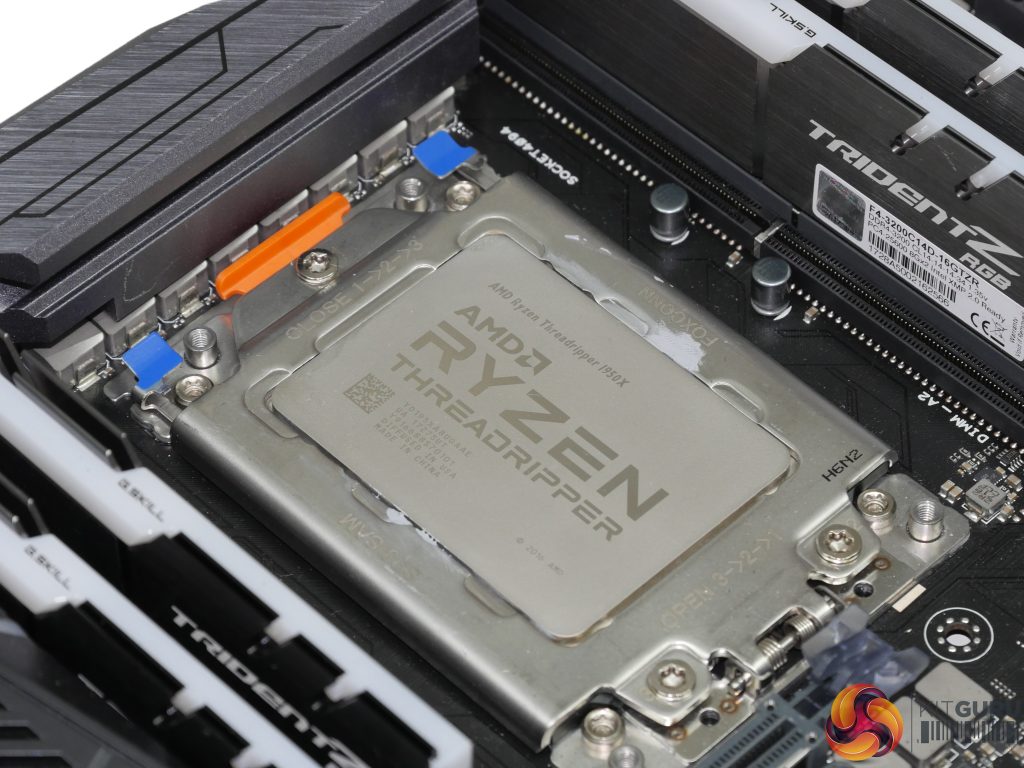
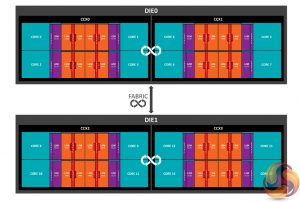
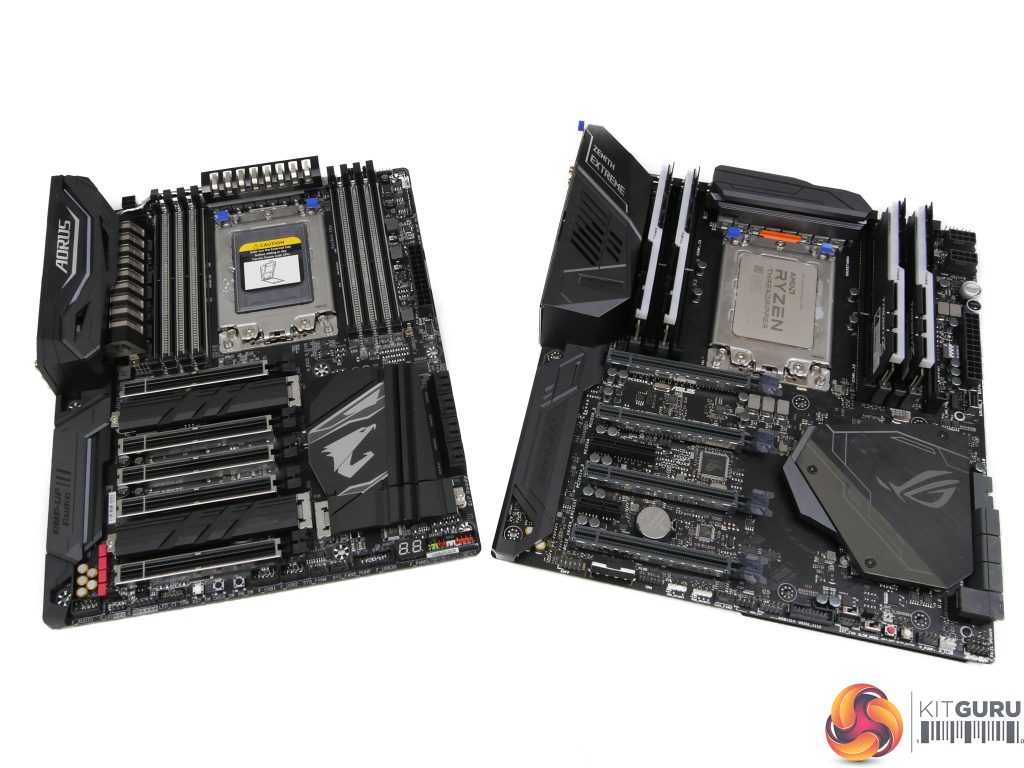
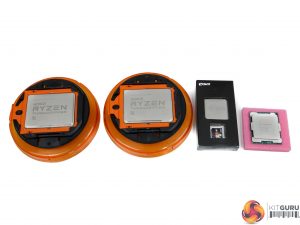
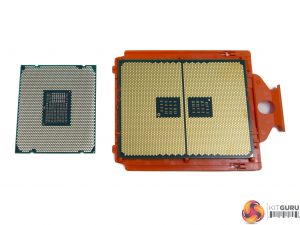
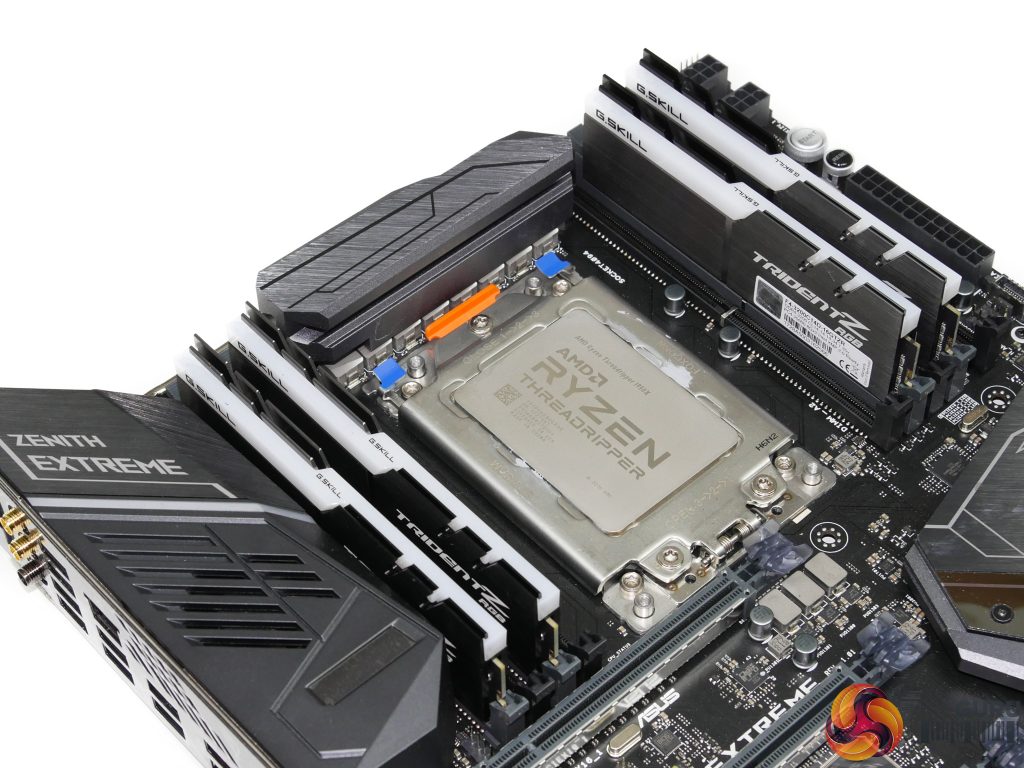
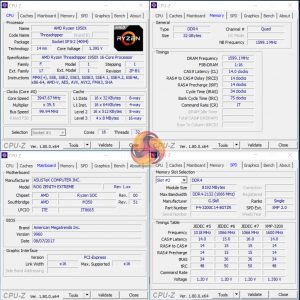
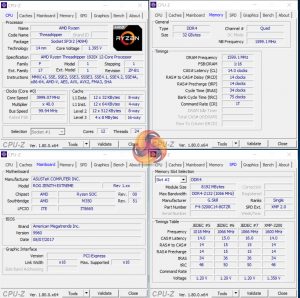
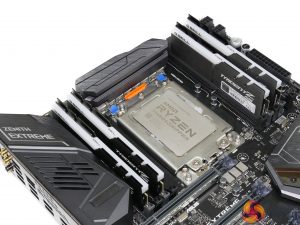
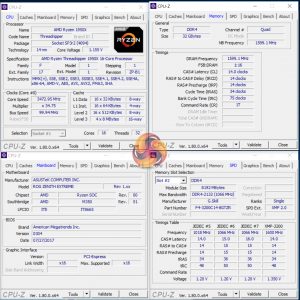
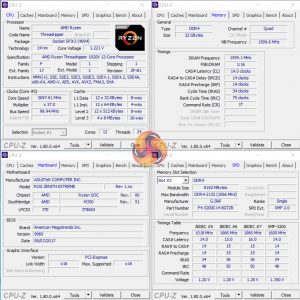
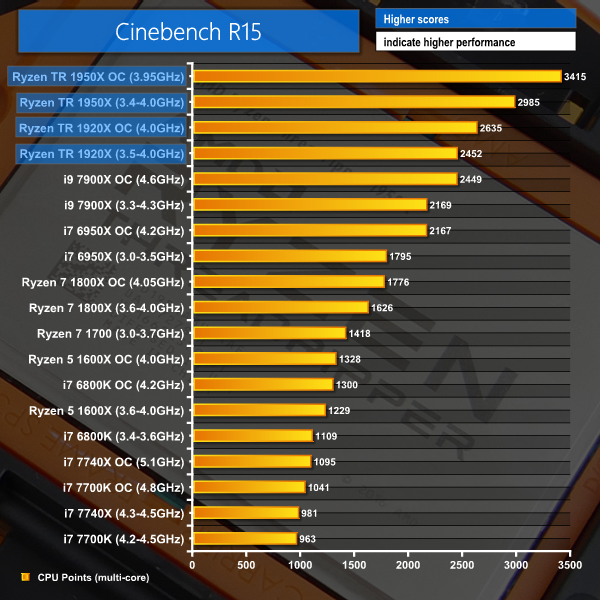
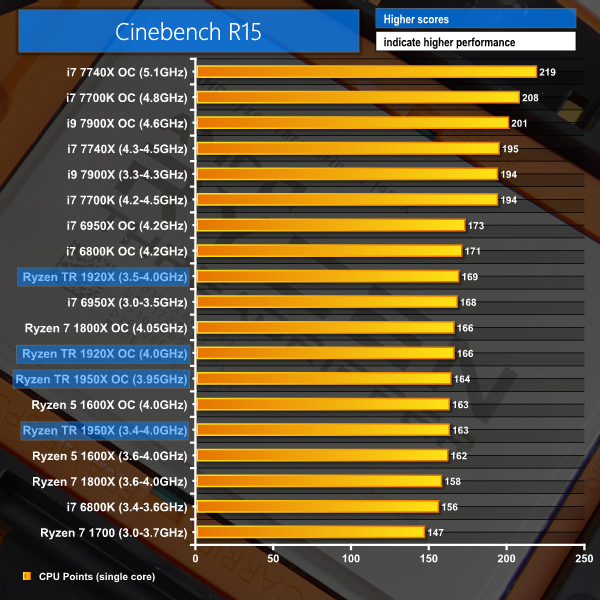
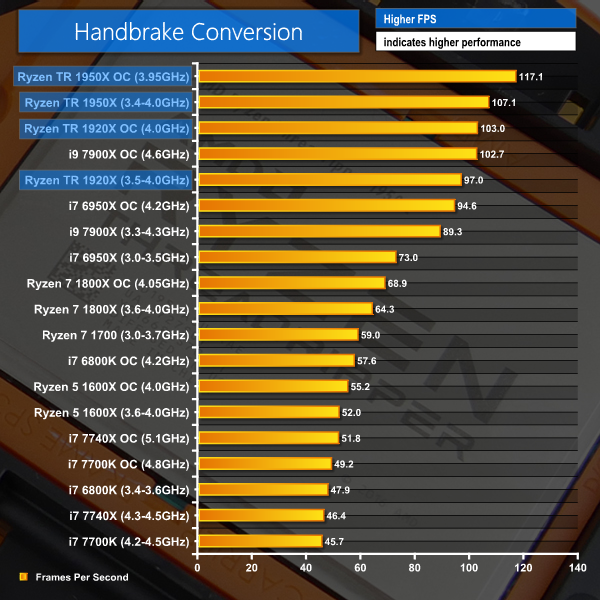
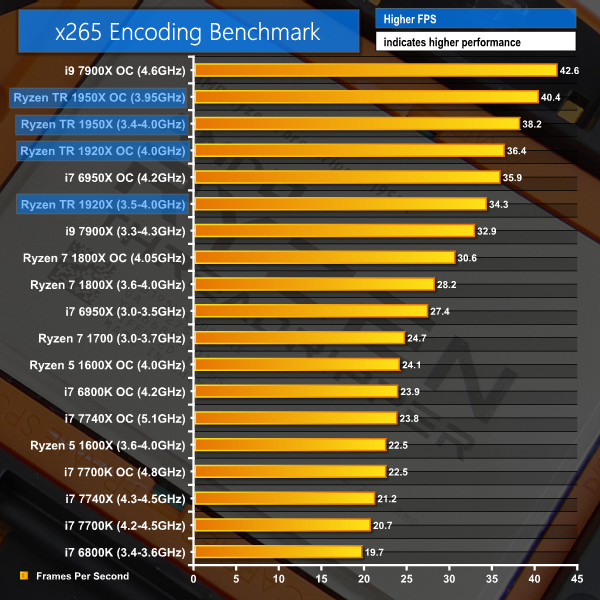
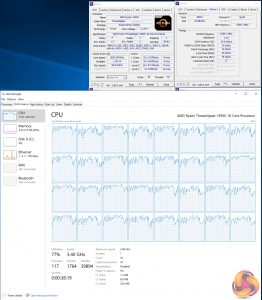
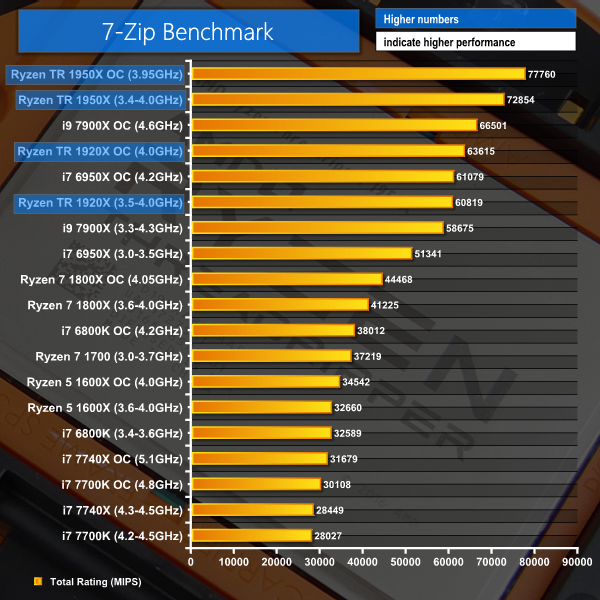
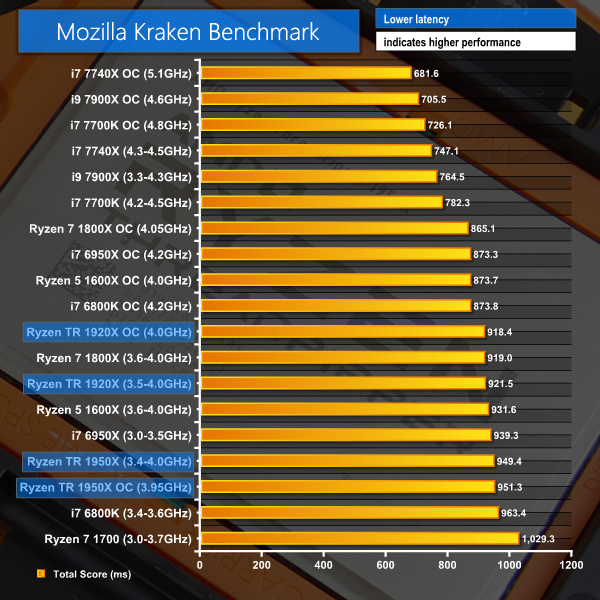
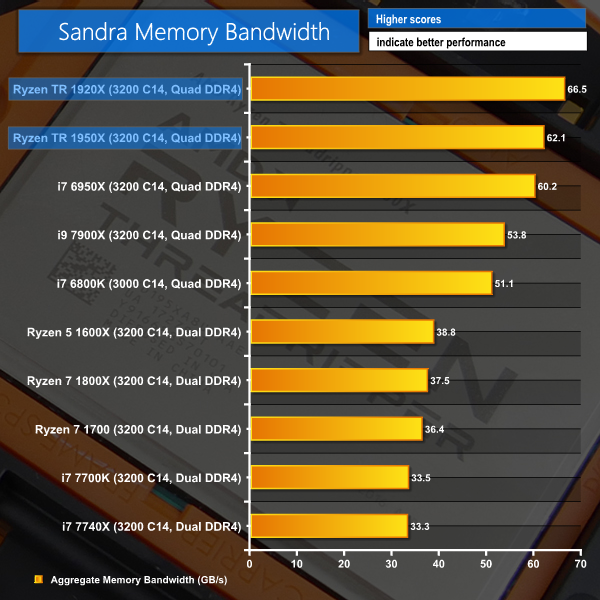
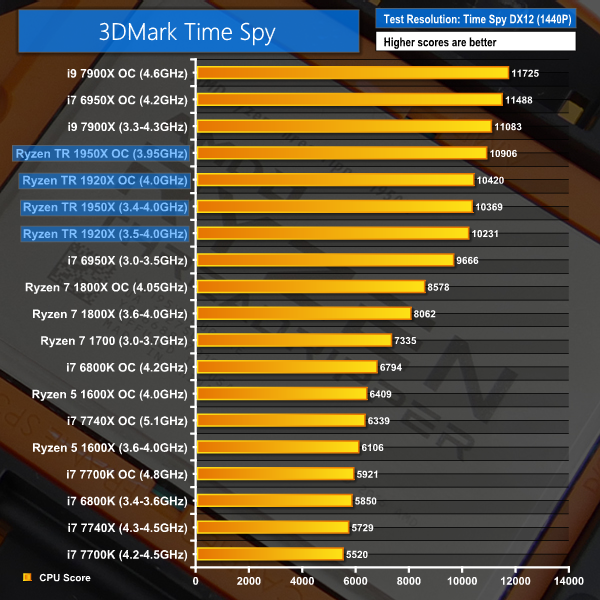




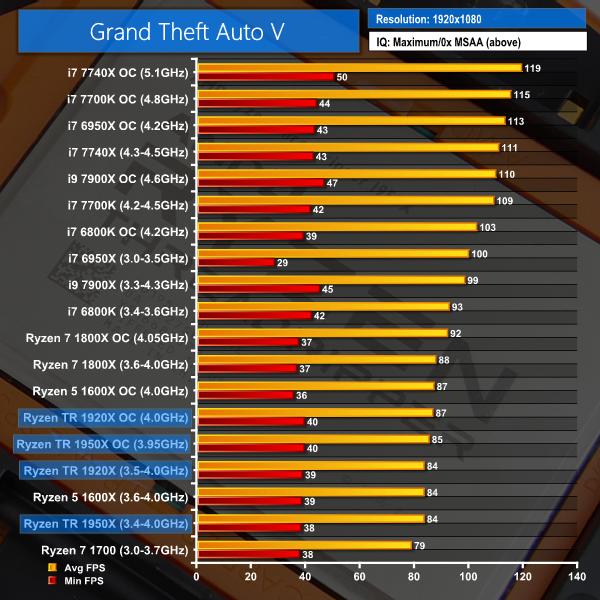
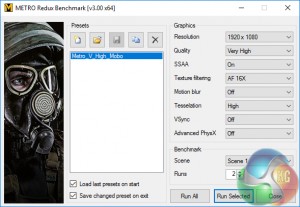
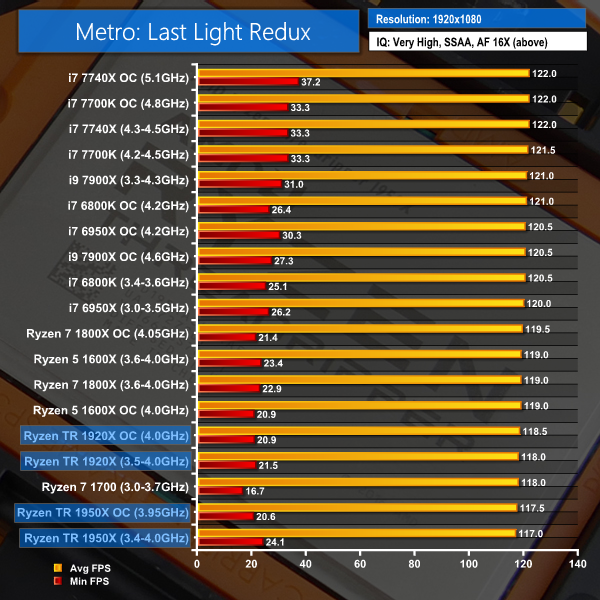

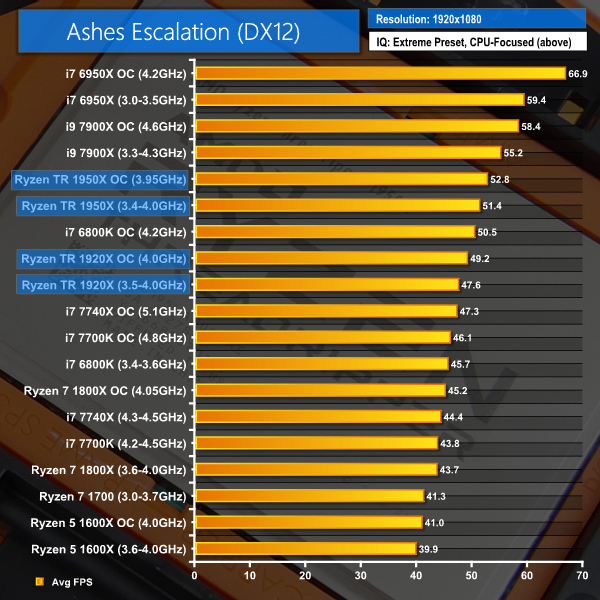

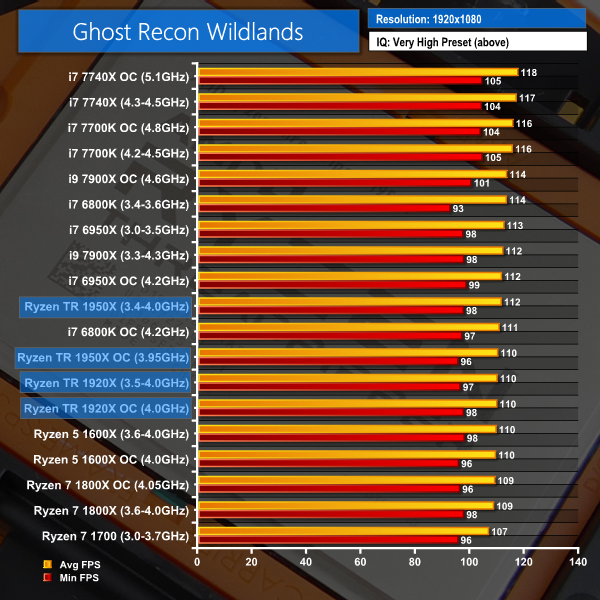


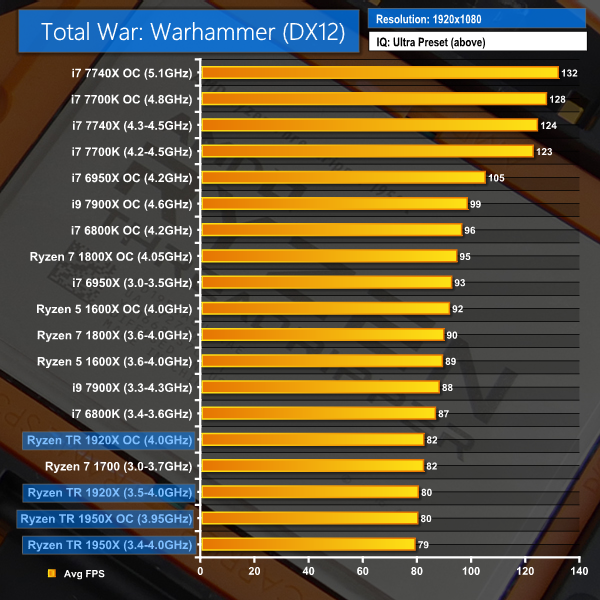
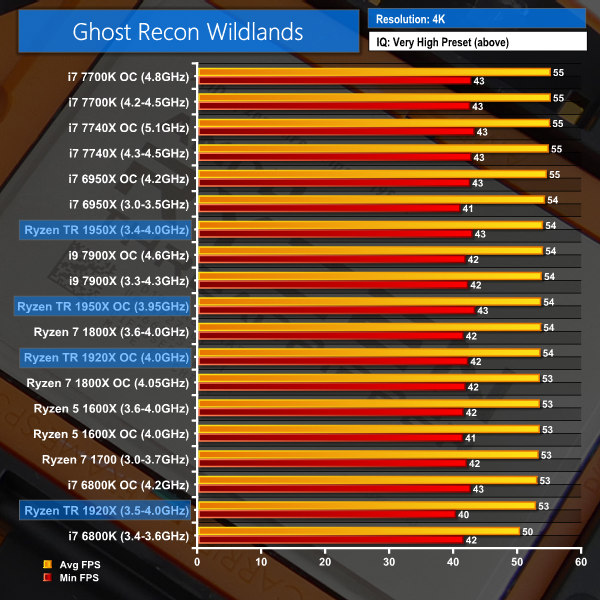




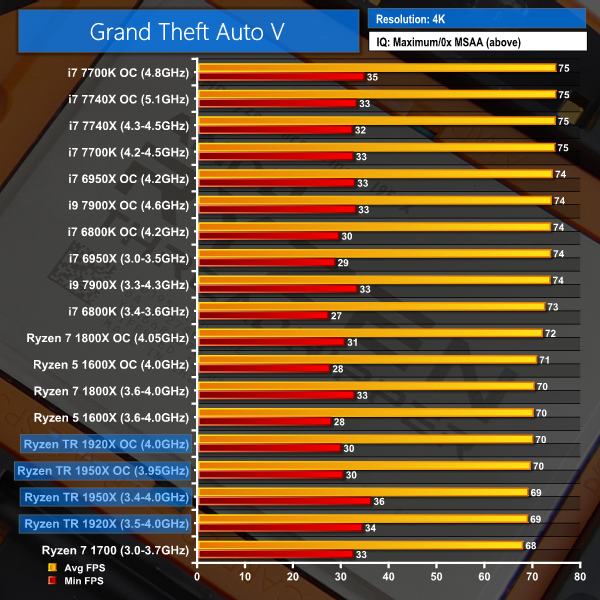
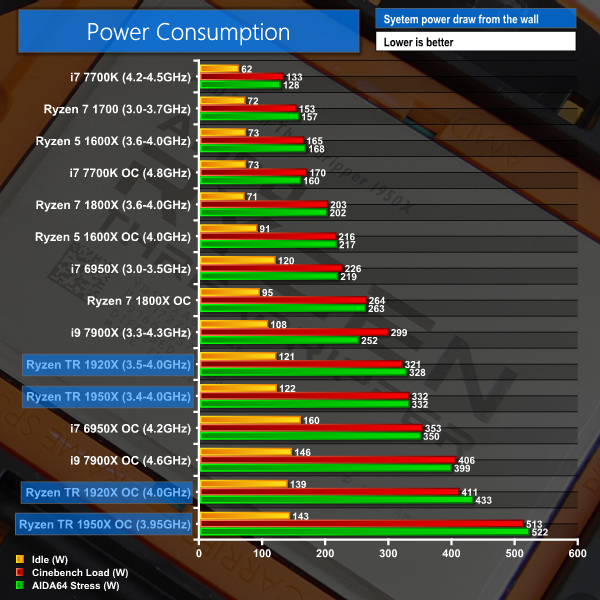
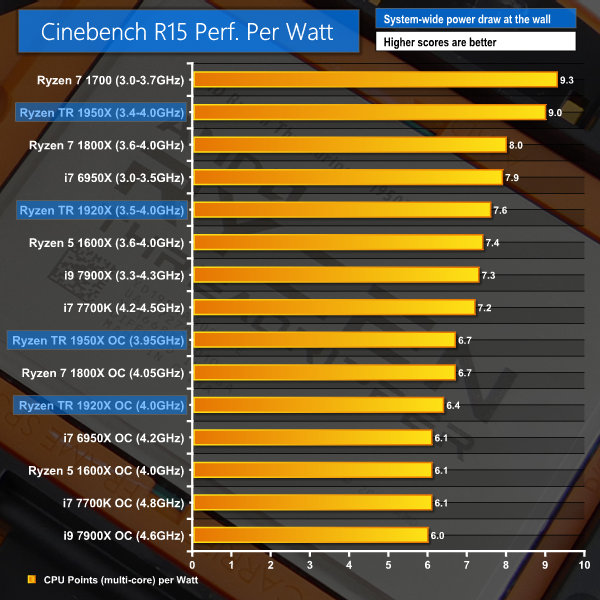
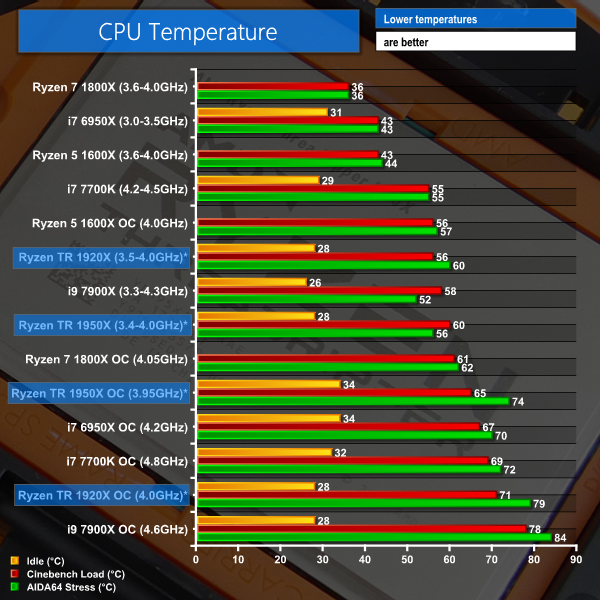
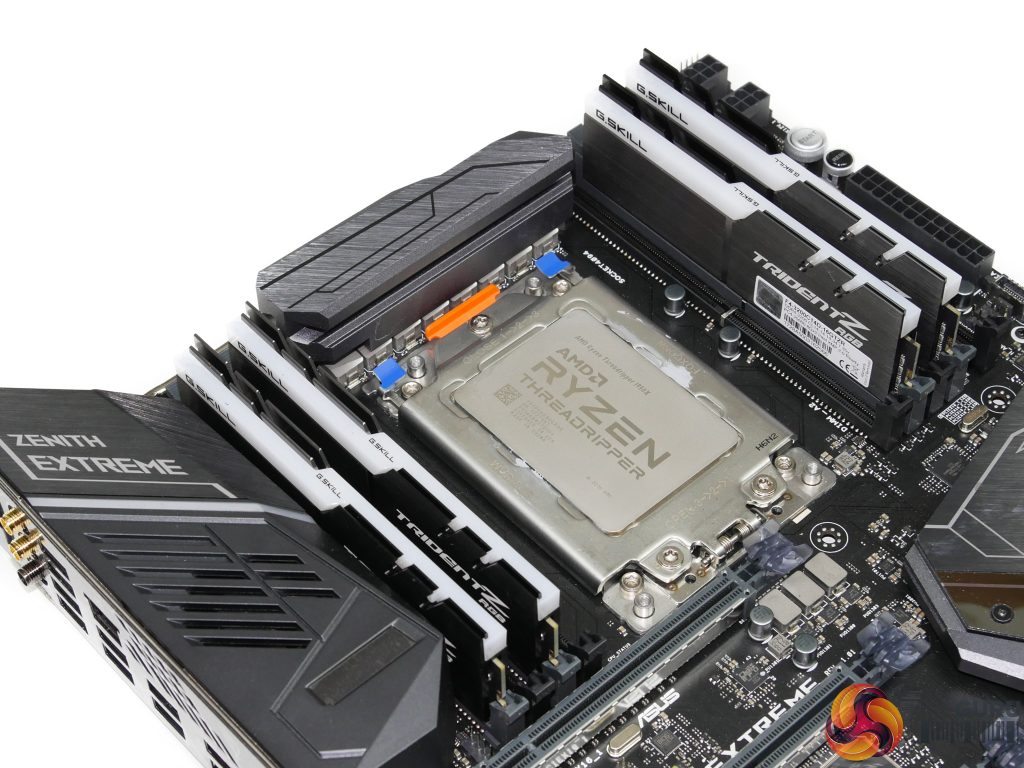
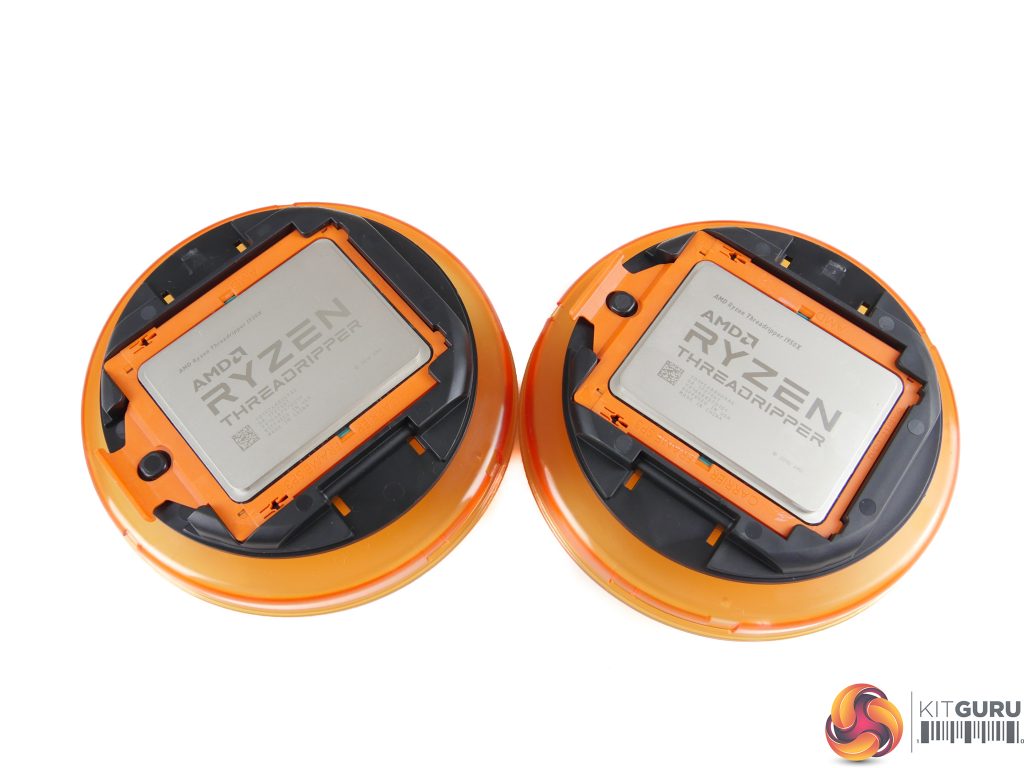


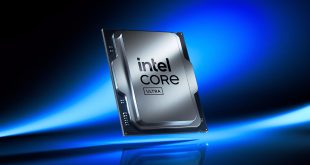
So it’s a beast for productivity [if it’s capable of delivering reliability in the long run], and it’s just fine for gaming, but not as cool as Intel. Not bad, not that great either. No reason to go away from X299 for now. I wonder how will the 12 – 18core Intel fare, both with performance and prices. Great review, proving my point in many discussions, thank You 🙂
so single core comparation is done with intel set at 4.5-5GHz and AMDs at 4.0GHz, and you’re surprised of that Intel’s is better 😐
So to test the maximum overclocked speeds of each you want Luke to achieve a 4.5ghz overclock on the Ryzen even though its just not possible. Perhaps Gandalf can help him with some magical powers.
Yes. All testing is done at stock and the realistic achievable overclocks on each CPU. Throttling Intel back to X GHz would be unfair if the Intel chips can OC further. Just as it would be unfair to throttle back Ryzen CPUs if they have faster clock speeds than their competitors.
Stock and realistic OC frequency is what we always test on all CPUs. Intel’s Skylake-X and Kaby Lake CPUs tend to OC higher than AMD’s Ryzen chips so that’s what people run their frequencies at and that’s what we test with.
Luke
Ok, i get that but …
1. Same cooling was used for both?
2. Is TR restricted, or why can’t it go pass the boosted clocks?
So, considering that AMD again gives 50 and 60 percent more cores for a same or the similar price those CPUs are a beasts for people who need productivity and content creation CPU
Who games at 1080p with a £1000 CPU and a GTX1080 ti? Wasn’t Ryzen equal to its intel equivalent at higher resolutions, Is this the same with ThreadRipper?
“Cons” in the review are so depraved you can not even imagine, and lacking 1 star out of 10…. For what? For not being available for free?
Oxymorons
I have to slightly disagree with the gaming analysis. Many times the reason RYZEN doesn’t perform well in gaming is that game developers still haven’t had enough time to optimize the RYZEN platform. Game developers haven’t had enough time with the AMD RYZEN hardware development kits as of yet.
The same cooling was used for all CPUs (280mm AIO) except Threadripper which used a 360mm Asetek AIO due to mounting compatibility.
The frequency limits for Ryzen look to be related to the manufacturing process technology used by AMD. At its own fabs, Intel looks to have the ability to manufacture dies that can operate at a higher frequency in general.
1080P and a fast GPU helps isolate CPU performance by ensuring no resolution- or GPU-induced bottlenecks are introduced. Our 4K testing shows Ryzen to be far more competitive against Intel when the performance onus is planted more firmly on the GPU.
Ok, thank you. Maybe Threadripper will be able to get higher OCs with some bios updates, how it happened to Ryzen 🙂
Are you confident its not a fabric/zeppelin die limitation rather than the zen core or the ccx?
If that hasnt been eliminated, perhaps raven ridge can shed some light eventually? As i understand it, and given it must be low power for mobile, it will be a single 4 core zen ccx & a single vega gpu on a die like ryzens zeppelin die. Point being, maybe it can clock better in that die form.
Agreed. Irrespective of the amount cooling available, no multi cores CPU would survive a Prime95 stress test on all cores for 30 minutes, let alone 1 hour or more. Prime95 should be taken off the web.
Current rumors predict $1,700 for the 16-core, and $2,000 for the 18-core.
Hey Luke. May I ask how you obtained the all-core turbo frequencies of the 1920X and 1950X? And how confident are you that they are correct? I ask, only because other sources have consistently stated 3.60 GHz for the 1950X. Thank you very much for this in-depth review.
Those are not rumors, they are official Intel pricing, confirmed by multiple outlets and reviewers.
18 core Intel i9 will be $1999.99 (USD)
16 Core Intel i9 will be $1799.99 (USD)
Price v Performance is going AMD’s route, they will end up taking a good portion of the HEDT market with their aggressive pricing and their performance.
“But muh i9 is faster”..
It also has less PCI-E lanes, uses more energy, when overlocked Intel’s 10 core gets hotter than the 16 core AMD, and dollar per dollar is less of a value. This again has been confirmed in testing via many respected hardware outlets/reviewers.
I only have 12 years as an IT professional in hardware management systems, what would I know.
They got the 16 core 1950X to 5.2Ghz on LN2 (Liquid Nitrogen), while that was obviously not representative of real world operations, it did show what can be done.
The issue Intel faces is the technology change that is currently happening where we are switching software from single core/thread ops to multicore and having code recognize the maximum amount of cores possible.
How is this a problem for Intel?
Despite having an immense about of capital to work with an state-of-the-art R&D facilities, Intel’s latest chips have issues with overclocking all cores and remaining efficient. In fact if you look at Intel’s turbo boosts they downclock heavily after 4 cores to keep TDP and energy consumption manageable and competitive. Intel’s biggest weakness is their ability to maximize silicon yields, this is one of the reasons they charge so much for their CPU’s, while AMD’s current approach allows them to scale as they need to with less transistors required on a single die, maximizing yield.
At this current rate I fully expect AMD to release their Zen 2 7nm CPU before Intel gets Cannon Lake (10nm) CPU’s out as AMD is already reporting over 80% yields with 14nm silicon, and anything above 60% yield allows for very competitive prices.
Okay, thanks John. And for the record, yes, I am fully supportive of Threadripper. Intel has been screwing people over for too long.
I’m not sure why you decided to say this, however.
Intel chips are NOT cool. Not even the 91w i5’s. Unless if you think 80c on watercooling for a STOCK i5 Skylake is cool.
Threadripper better as $1k for 16 cores 32 threads when intel like $2k for that. Ya had enough of limitations and greed
Why was enermax aio not used?
I agree. The 16-core 1950X was available on Amazon for $800 not too long ago.
Not as “cool”?, in what sense exactly? as in an over priced haircut kinda cool?
ur obviously a fanboy dick swinger, the only diff. this time u aint playing with the biggest dick.
All reviews out there on the net show Threadripper is faster in basically all productivity apps other than some outdated software that runs better on quads, TR uses less power, has better SMT, has more IO, costs less and has excellent motherboard support.
Wake up from ur delusional dream Bub, just ’cause ur sore that u overpaid for an overvolted stove top cpu that don’t do shit, don’t mean u have to spread ur bull shit propaganda.
Love the 1950x. Runs well at 4.1GHz, and running Prime95 simultaneously w/CPU-Z stress (all cores at 100%), T 105 fps. Other benchmarks show very good performance and durability.